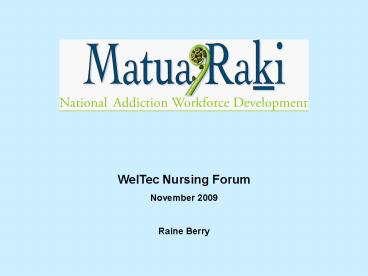WelTec Nursing Forum - PowerPoint PPT Presentation
1 / 34
Title:
WelTec Nursing Forum
Description:
45% of these had coexisting drug disorder and/or alcohol abuse ... with diagnosed mental health disorder twice as likely to use alcohol hazardously ... – PowerPoint PPT presentation
Number of Views:29
Avg rating:3.0/5.0
Title: WelTec Nursing Forum
1
WelTec Nursing Forum November 2009 Raine Berry
2
Nursing and Addictions
- Coexisting Disorders
- The Addictions Nursing Workforce
- Current Treatment Situation
- Workforce Issues
- Matua Raki Strategies
- Workforce Vision
3
(No Transcript)
4
Coexisting Problems
- Coexisting Capable
- Coexisting Enhanced
- CEP is common
5
Prevalence of CEP
- NZ MH Survey 2004 Te Rau Hinengaro
- 20.7 mental health disorder (L/T)
- - 45 of these had coexisting drug disorder
and/or alcohol abuse - - 31 met criteria for alcohol dependence
- - 37 more than one disorder
- - 7.7 multiple
- 40 with substance use disorder also met criteria
for an anxiety disorder and 29 a mood disorder
6
CEP Associated Issues
- Major impairment in role functioning
- High prevalence of chronic medical issues e.g.
chronic pain, cardiovascular disease, high BP,
respiratory conditions, diabetes - Suicidal behaviour associated with increased
number of disorders - People with diagnosed mental health disorder
twice as likely to use alcohol hazardously
7
(No Transcript)
8
Dependence Diagnosis in NZ Outpatient
SampleAdamson et at 2006
9
Coexisting Disorders in an AOD Outpatient
Sample Adamson et al 2008
10
The Addictions Nursing Workforce
11
AOD Workforce Demographics
12
Postgraduate Qualifications
13
Routine Activities
14
Skills nurses bring to addictions
- Health education
- Assessment and treatment planning
- Coordination of care from assessment to discharge
- Pharmacotherapy knowledge
- Withdrawal management
- Monitoring health, bloods, BP etc
- Crisis intervention
- Risk Management
- Consultation/liaison
- Counselling
- Documentation
15
Perceived barriers to nurses wanting a career in
addictions
16
Nursing Roles in the Addiction Context
- 85 of nurses in designated nursing positions
- Previous poor recognition of advanced practice
roles - 51 intend to work toward an advanced practice
role including 30 Nurse Practitioner - Expanded and extended practice scope
17
AOD Treatment Survey
18
AOD Treatment Position
- Many services struggling to meet demand
- - detox (residential medical and social)
- - youth services
- - coexisting problem service
- - residential programmes (incl. AD Act
beds)
19
Treatment Position
- Influencing factors
- - Lack of new positions
- - Lack of competent practitioners able to
take clinical responsibility - - Doubling of referrals from Corrections since
the new Sentencing Act
20
Workforce Issues
21
Recruitment
- More workers in NZ labour market will retire than
be recruited over next 25 years - Labour demand will exceed supply in AOD from 2011
- Attaining and attracting qualified and skilled
staff - Difficulty recruiting for specialist positions
(detox, CEP)
22
Key issues
- Aging workforce
- - AOD age 49 in 2008, age 42 in 1998
- - National labour force age 40 in 2006, age
36 in 1991 - Workforce Trends
- - Rise in qualification level
- - Rise in numbers of other Europeans (6 2004,
16 2008, Nurses 29) - - More counsellors, fewer nurses and fewer
Maori - Retention
- - high turnover (41 in AOD workforce for less
than 5 years)
23
Matua Raki Strategies
24
Matua Raki Projects
- Capacity Building
- Forecasting
- Consumer workforce
- Capability Building
- - Scholarships, Internships
- - Mobile training and short courses
- - MI Internships
- - Families with complex and challenging issues
- - CEP enhancement project
- - Responses to methamphetamine problem
25
AOD Advanced Practice Nursing Project
- Promote flexible post-graduate AOD/addiction
advanced practice professional development
nursing pathways within clinical masters
programmes leading to clinical Nurse Specialist/
Nurse Practitioner that incorporate postgraduate
papers - Strengthen national nursing leadership networks,
including amongst nurses on the Nurse
Practitioner pathway - Strengthen strategic partnerships with nursing
leaders within workforce programmes
26
AOD Advanced Practice Nursing Project
- Support strategic and operation planning within
the Addiction and Mental Health sector to develop
the infrastructure for the implementation and
ongoing support of advanced AOD/addiction
advanced practice nursing roles - Assist individual nurses with achieving /
recognition of advanced practice status
27
Summary
28
- The capability and capacity of the AOD treatment
sector improving however increasing demands on
services continue - Increasing the numbers in the addiction workforce
not enough - Nursing workforce needs to increase
- New dedicated nursing positions created
- Pathways for Nurse Practitioners supported
- New approaches needed to
- - recruitment
- - funding
- - treatment provision
29
Workforce Vision
30
By 2012
- Confident and hopeful workforce
- Skilled / capable specialist workforce
- Skills and knowledge gained supported and
utilised in the workplace - Consumer and peer workforce well established
- Increased Maori and Pacific Workforce
- Advanced nursing roles well established with
Nurse Practitioners employed in each specialist
service - Increased capability in PHC and allied workforces
to address addiction issues - The average age of the workforce matches the
National Labour force average - Career in Addictions attractive to graduates and
school leavers
31
Postgraduate AOD Courses
- National Addiction Centre
- Auckland University
32
(No Transcript)
33
Prevalence of Mental Health Disorders
- 39 of people gt16 years met criteria for a
disorder at some time before interview - Life-time (L/T) Risk 46.6
- Anxiety 24.9 L/T Risk 28.8
- Mood 20.2 L/T Risk 28.4
- Sub Use 12.3 L/T Risk 13.8
- Eating 1.7 L/T Risk 1.9
- Te Rau Hinengaro 2006
34
12 month Prevalence of Substance-Use Disorders
- 2.6 alcohol abuse 1.3 dependence
- 1.2 drug abuse 0.7 dependence
- 0.9 Cannabis abuse 0.5 dependence
- Higher in Maori, Pacific, younger people, males,
people with less education, less income































